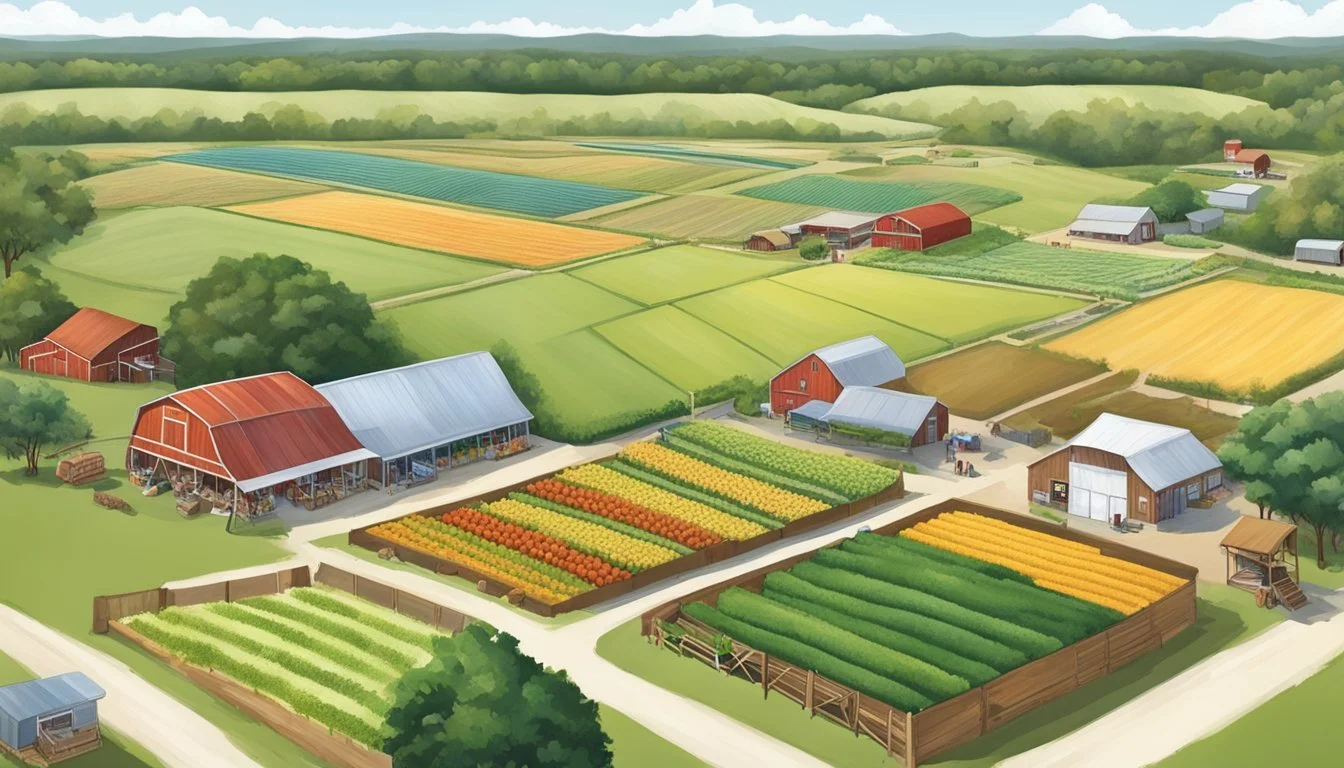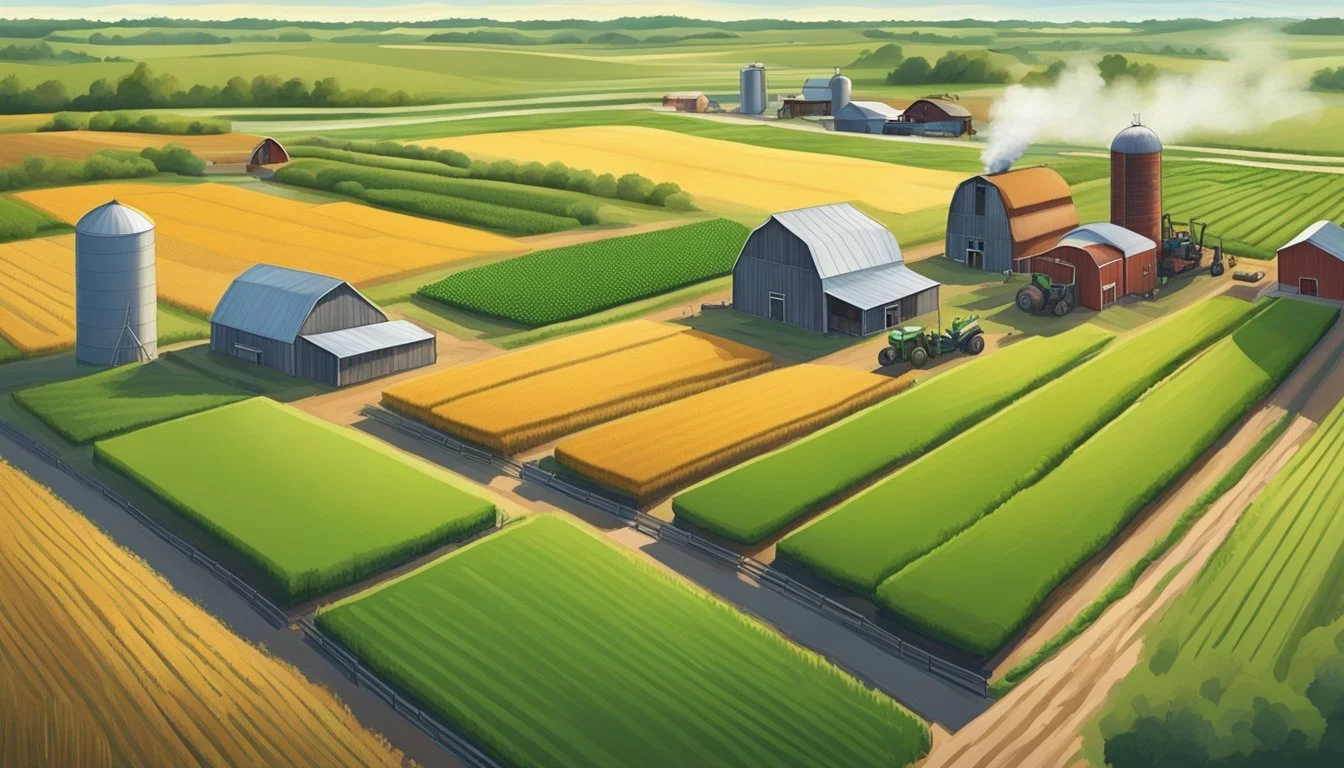Farming Communities in Alabama
Sustaining Tradition and Innovation
Alabama boasts a rich tapestry of farming communities, each contributing uniquely to the state’s agricultural landscape. These areas are not only vital for food production but also embody the cultural and historical essence of the region. From the historic town of Springville, known for its festivals and crafts, to the bustling farmland of Baldwin County, the diversity of agriculture in Alabama is noteworthy.
Many of Alabama's farming communities, such as those in Lawrence County with their modern broiler farms, form the backbone of the local economy. These communities host various agricultural activities ranging from poultry farming to cultivating vast tracts of crops. Enthusiasts and prospective buyers can explore numerous properties through platforms providing extensive listings of farms and ranches for sale.
The charm of Alabama's rural towns lies in their blend of traditional farming practices and modern agricultural technologies. Areas like Atmore in Escambia County offer income-producing farms, highlighting the economic potential for those interested in agricultural pursuits. These communities not only sustain their local economies but also contribute significantly to the state's agricultural output.
Historical Development of Farming in Alabama
Alabama's farming communities have experienced significant transformations, from early cultivation by indigenous peoples to the mechanization and diversification of modern farms. This section explores key periods that shaped the agricultural landscape of Alabama.
Early Agricultural Practices
Agriculture in Alabama began with the indigenous populations around 6000 B.C. They cultivated native crops like corn, beans, and squash. The arrival of European settlers introduced new farming techniques and crops, including wheat and cotton.
By the antebellum period, plantations dominated the landscape. Large farms, ranging from 500 to 1,000 acres, primarily focused on cotton, which was Alabama's main economic driver. These plantations relied heavily on slave labor, shaping the social and economic structures of the region.
Transformation from Plantations to Diverse Farms
Following the Civil War, Alabama's farming structure began to change. The abolition of slavery led to sharecropping and tenant farming, providing former slaves and poor white farmers a means to work the land.
The advent of mechanization in the early 20th century further transformed agriculture in Alabama. Urbanization and the shift to diverse agricultural practices reduced the dominance of cotton. By 2015, Alabama's agricultural landscape diversified to include a variety of crops and livestock, marking a significant departure from its plantation past.
Geographical Distribution of Farms
Alabama's farm distribution exhibits distinct patterns, with key counties like Limestone, Dekalb, and Baldwin playing significant roles. Differences between rural and metropolitan farming areas further highlight the diverse agricultural landscape.
Significance of Limestone, Dekalb, and Baldwin Counties
Limestone County features prominently in Alabama's agricultural scene. Known for its fertile soil, this northern county supports extensive farming activities, particularly in soybeans and corn. Dekalb County is another critical area, especially famous for poultry farming. This county's topography and climate are well-suited for diverse agricultural practices. Baldwin County, located in the southern part of the state, excels in crop production, with a focus on peanuts and cotton. Its proximity to the Gulf of Mexico also benefits the local farming economy, promoting both year-round growing seasons and diversified farming operations.
Rural Versus Metropolitan Farming Areas
Rural Alabama remains the backbone of the state's farming activities. Regions far from urban centers often have larger plots of land and a greater focus on traditional farming methods. In contrast, farming in metropolitan areas like Huntsville and Birmingham is limited by space constraints but benefits from closer markets and advanced technologies. Urban farms may focus on high-value crops such as specialty vegetables and organic produce, leveraging modern farming practices, including vertical farming and hydroponics. This rural-urban divide reflects not only in farm sizes but also in the types of products grown and the methods employed.
Agricultural Economy and Local Markets
Agriculture is a cornerstone of Alabama's economy, influencing both rural and urban areas. The prosperity of local markets plays a pivotal role in supporting farmers and fostering economic growth through various initiatives and infrastructure.
Impact on Alabama's Overall Economy
Agriculture in Alabama significantly contributes to the state's economy. The 2022 Census of Agriculture highlights that the state hosts over 37,000 farms, generating more than $9 billion in market value.
This sector supports numerous jobs, with the majority of farms being family-owned or operated through partnerships. The state's economy benefits from property taxes, loan collaterals, and investments in infrastructure driven by the agricultural sector.
Farm to Table: The Role of Local Economics in Restaurants
Local restaurants in Alabama heavily rely on nearby farms for fresh, high-quality produce. This collaboration strengthens the farm-to-table movement, ensuring that locally grown foods reach consumers swiftly.
Farmers provide essential ingredients such as poultry, pecans, and various vegetables to restaurants, which helps reduce transportation costs and supports local economies. These partnerships also promote sustainable practices and healthy eating habits among the community.
Alabama's Markets and Trading Infrastructure
Alabama's agricultural markets and trading infrastructure are vital for maintaining the state's economic stability. Major markets facilitate the trade of agricultural products across the region, ensuring that farmers can sell their goods efficiently.
The development of robust trading networks allows for a consistent supply of agricultural products to both local and national markets. This infrastructure also supports rural development and fosters economic resilience in farming communities.
Farming Operations and Management
Managing farming operations in Alabama involves a blend of traditional practices and modern techniques. Innovations in technology and a push for sustainable and organic farming practices are helping reshape the landscape.
Farm Management and Structure
Farm operations in Alabama are often family-run and passed down through generations. Newer farmers are bringing fresh perspectives and innovations to traditional farming methods. This intertwining of old and new farming operations includes farm management teams, who provide expertise to enhance profitability and sustainability.
In addition to traditional crops such as cotton and soybeans, farmers are adopting diversified crop strategies to increase resilience. They utilize research-based economic principles and farm management techniques to optimize their operations and make informed decisions.
Influence of Technology and Internet
The integration of technology has significantly impacted farming operations in Alabama. High-speed internet enables farmers to access real-time data on weather, market prices, and advanced agronomic practices.
Innovations such as precision farming tools help monitor soil health, manage water usage efficiently, and increase crop yields. Community-supported agriculture (CSA) models thrive through online platforms, allowing farmers to connect directly with consumers, facilitating better marketing and sales strategies.
Sustainable Practices and Organic Farming
There is a growing emphasis on sustainable and organic farming in Alabama. Farmers increasingly adopt practices that protect the environment, conserve resources, and support long-term productivity. Methods such as crop rotation, composting, and biological pest control are becoming more common.
Organic farming in Alabama is driven by both market demand and environmental necessity. Producers are embracing certifications and sustainable methods to cater to a growing market for organic products. This shift not only helps in meeting consumer preferences but also ensures the health of the farming ecosystem.
Agricultural Practices and Innovations
Farming communities in Alabama employ a variety of techniques to maximize productivity in crop cultivation, livestock rearing, and aquaculture. The focus includes adopting modern agricultural methods, diversifying plant species, and optimizing the use of pesticides and fertilizers.
Crop Selection and Plant Diversity
Alabama's farming communities prioritize crop diversity to enhance soil health and reduce the risk of pest infestations. They grow cotton, a staple crop, alongside vegetables like tomatoes, squash, and greens. This approach not only improves the ecosystem but also increases resilience against adverse weather conditions.
On-farm demonstrations often showcase innovative planting methods and crop rotations. These practices maintain nutrient-rich soil and better water absorption. Farmers also incorporate cover crops to protect soil from erosion and add organic matter. This multi-crop system ensures sustainable agriculture and efficient use of land resources.
Livestock, Poultry, and Aquaculture
Alabama's agricultural landscape includes significant contributions from livestock and poultry farming. The state is known for producing broiler chickens, which are a major part of its agricultural economy. Farmers utilize advanced techniques in poultry housing and feeding to ensure optimal growth and health of the birds.
Aquaculture is gaining traction with species like catfish and tilapia being farmed. Efficient breeding programs and water management practices are crucial for maintaining healthy fish stocks. Livestock farms often implement rotational grazing to minimize land degradation and enhance forage quality, benefiting both the animals and the land.
Use of Pesticides and Fertilizers
Responsible use of pesticides and fertilizers is a key focus for Alabama farmers. Integrated Pest Management (IPM) is commonly practiced to target pests while minimizing the impact on non-target species. This approach includes using biological controls and crop rotation to manage pest populations.
Fertilizers are applied based on soil tests to avoid overuse and to ensure that crops receive necessary nutrients. Modern techniques like precision agriculture allow for the efficient distribution of inputs, reducing waste and environmental impact. These methods help farmers achieve higher yields while maintaining ecological balance.
Environmental and Health Considerations
Farming communities in Alabama face various environmental and health challenges. Key areas of focus include maintaining soil health, managing pests and weeds effectively, and conserving wildlife and ecosystems.
Soil Health and Fertilizer Use
Healthy soil is essential for sustainable agriculture. Alabama farmers often employ methods to enhance soil fertility, such as crop rotation and the use of cover crops. These practices help maintain nutrient levels and reduce erosion.
Fertilizer use must be managed carefully to avoid contaminating water supplies. Precision agriculture techniques, including soil testing and targeted application, help minimize overuse. The adoption of organic fertilizers is also gaining popularity, supporting environmentally-friendly farming.
Pest and Weed Management
Effective pest and weed management is critical to protect crops. Integrated Pest Management (IPM) strategies are prevalent in Alabama, combining biological, cultural, and chemical methods. Farmers use natural predators and crop diversity to control pest populations.
Chemical herbicides and pesticides are used sparingly and with precision to reduce harmful impacts. Training and education provided by Alabama Extension services ensure that farmers are equipped with the knowledge to use these substances safely and effectively.
Wildlife Conservation and Ecosystems
Conserving wildlife and maintaining healthy ecosystems are priorities for Alabama farmers. Initiatives such as the Streambank Restoration Initiative aim to rehabilitate degraded areas and improve water quality. These efforts enhance biodiversity and support aquatic habitats.
Riparian buffer zones and wildlife corridors are established to protect natural habitats from agricultural runoff. Farmers also participate in programs that encourage the preservation of native species and the protection of endangered wildlife.
Understanding and implementing these diverse practices ensure that farming activities are sustainable and environmentally friendly, benefiting both the community and the ecosystem.
Regulatory and Zoning Issues
Farming communities in Alabama navigate a complex web of zoning laws and environmental regulations. These policies influence land use, farming operations, and compliance with health and safety standards.
Farming Zones and Land Use Policy
Zoning in Alabama includes specific designations such as agricultural and historic preservation zones. Agricultural zoning caters to farming and related activities, thereby safeguarding rural land. Historic preservation zoning focuses on conserving historical properties and districts, often requiring adherence to strict guidelines for development and land use.
The Code of Alabama (Section 11-52-70) empowers municipalities to regulate land within their corporate limits. This affects how farming communities plan and execute their agricultural activities. These zoning laws strive to balance private property rights with community planning needs.
Health Inspections and Environmental Regulations
Health inspections and environmental regulations are crucial for maintaining the safety and sustainability of farming communities. Alabama's Right-to-Farm laws (§ 6-5-127 and Ala. Code § 2-6B-1 to 2-6B-7) protect farmers against nuisance lawsuits, provided they comply with established practices and regulations.
Farmers must ensure their operations meet state standards, from waste management to pesticide use. Environmental regulations usually include inspections to verify compliance with safety and environmental standards. These steps help protect the public and the environment, while also supporting sustainable agricultural practices and local ecosystems.
Education and Community Resources
Farming communities in Alabama benefit greatly from a robust network of educational programs and organizations working to promote sustainable agricultural practices. These resources help farmers, ranchers, and consumers alike.
Educational Programs for Sustainable Farming
The Alabama Cooperative Extension System (ACES) offers a variety of educational programs aimed at promoting sustainable farming. With support from institutions like Auburn University and Alabama A&M University, ACES brings research-backed solutions to the field. Programs focus on sustainable practices, including crop rotation, soil health, and pest management, helping farmers enhance productivity and environmental stewardship.
Another critical initiative is the Alabama Beginning Farmers Project, which provides training and resources for aspiring farmers. Funded by grants from the USDA, the project collaborates with various agencies and producer groups to deliver practical training. Workshops and field days cover topics like organic farming, financial planning, and market access, creating pathways for new farmers to succeed.
Role of Organizations like ASAN
The Alabama Sustainable Agriculture Network (ASAN) plays a vital role in educating and supporting farming communities within the state. ASAN facilitates knowledge sharing through its annual forums, workshops, and farm tours, focusing on sustainable ag practices. These events offer farmers and consumers opportunities to learn about organic farming, food sovereignty, and community-supported agriculture (CSA).
ASAN also acts as an advocate for small farms in Alabama, providing platforms for farmers to connect with local consumers. By emphasizing networking and collaboration, ASAN strengthens community bonds and fosters a resilient agricultural ecosystem. The organization’s resources are indispensable for those invested in creating sustainable and thriving local food systems.
Cultural and Social Impact
Farming communities in Alabama have played a significant role in shaping the region's cultural and social framework. The influence of agriculture extends beyond economic contributions, affecting traditions, tourism, and local events.
Agriculture's Influence on Alabama Culture
Agriculture deeply embeds itself in the daily lives of Alabamians. The rural landscape, marked by extensive farmland, cultivates a strong connection to the land. Traditions such as fairs and community gatherings celebrate the agricultural heritage. Practices like crop rotation and livestock rearing aren't just economic activities; they form part of the cultural identity.
Family-run farms are pivotal in transmitting agricultural knowledge and customs across generations. Local cuisine, heavily influenced by farm produce, showcases this bond. Traditional foods like cornbread and collard greens often start their journey on Alabama farms, ending on family tables across the state.
Tourism and Agricultural Events
Agricultural tourism is a thriving sector in Alabama. Events like the Alabama National Fair in Montgomery attract thousands, blending entertainment with education. These events offer a glimpse into the agricultural lifestyle, featuring livestock shows, crop competitions, and local art.
Farm tours, another popular attraction, allow visitors to experience farming operations firsthand. From pumpkin patches in the fall to springtime flower festivals, these activities promote rural tourism. The interaction between tourists and farming communities fosters an appreciation for agricultural practices and helps stimulate local economies.










